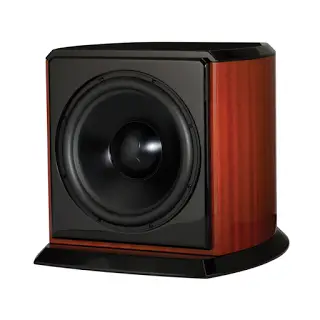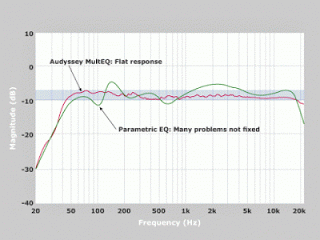Back in 2009 I wrote about the benefits of subwoofer equalization and I lauded the inclusion of subwoofer EQ on Revel’s B15 and B15a subwoofers. Revel’s included software had test tones from 20 hz to 100hz and you relied on an SPL meter to manually record the findings in the software. Even though it was only a 3-band EQ, it still made a difference.
Fast forward a few years and what a difference! Both in terms of the now wide-spread inclusion of EQ on AVRs and pre-pros but also in the quality difference that these products can make in difficult rooms and setups. I read about the different EQ technologies and finally got a shot to test out the difference EQ could make at a friend’s home. He had just purchased an Onkyo receiver with GoldenEar speakers. Placement was not optimal–the speakers were hung on-wall, there was a large media cabinet between and below the center channel and the rears were perched at the corners of the ceiling above and spread fairly wide. Of all the speakers, the subwoofer had only one place it could go and it was sandwiched between the side wall and media cabinet.
Circumstances dictated where the speakers had to go and this was a mixed use room. I ran Audyssey for him and (after reading all the articles, etc) made sure to put the microphone at ear level and propped it up on the couch. After measuring the locations, I fired up the receiver with its new Audyssey EQ curves loaded and we were in business.
In that room and in that setup, Audyssey did a great job in balancing out the sound and especially in its handling of the speaker distances. The real shining star, however, was what Audyssey did with the Golden Ear sub. When you hear good, tight bass, it’s a thing of beauty.
While the version on the Onkyo receiver wasn’t the pro version (which means I couldn’t look at any graphs or before and after results) the difference in the subwoofer was very noticeable. What took me less than 10-15 or so minutes with the Audyssey today would have taken me twice that with the old Revel software and the results are likely better given the additional filters that are now present in the newer setups.
Revel is now likely to raise the bar yet again with the introduction of its Rhythm2 sub. The whopping 18″ woofer of the sub, listing at $10,000 is certainly not in the PoorAudiophile’s budget, but it’s amazing to see where EQ is going and the advancements being made. (Read more about the Rhythm2 at Revel’s web site, HomeTheater, and Audioholics).
 |
| Revel’s Rhythm2 sub is massive. It boasts an advanced EQ system that should make fitting the sub into any difficult environment a breeze. |
There is one thing that is certain: optimal physical placement of your speakers still comes first and foremost, but if you have no choice and no further flexibility, using good EQ on your subwoofer and yield dramatic improvements. If the only bass you’re used to hearing and feeling is the kind that jams from a car that you can hear and feel a block down the road, then you have a serious awakening coming when you hear a properly setup and EQ’d subwoofer.
In my forthcoming blog posts, I’m going to specifically talk about Anthem’s ARC EQ and demonstrate the differences that it’s made in two different setups–both with monitors and full range speakers. I’ll then be profiling some of the different subwoofer EQ solutions on the market that are out there and compile a list, so even if you have a receiver or preamp without EQ, there’s no reason why you shouldn’t add an external EQ for the lower frequencies that benefit most.
















